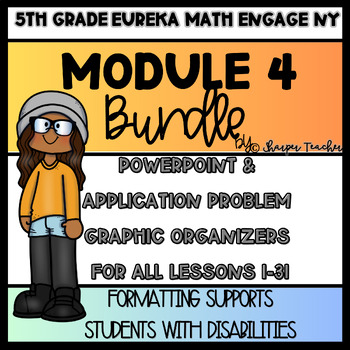5th grade Engageny Eureka Math Module 4 Bundle PPT & graphic organizers SDI SWDs
Sharper Teacher
57 Followers
Grade Levels
5th
Subjects
Resource Type
Standards
CCSS5.MD.A.1
CCSS5.MD.B.2
CCSS5.NBT.B.7
CCSS5.OA.A.1
CCSS5.OA.A.2
Formats Included
- Zip
Sharper Teacher
57 Followers
Products in this Bundle (2)
Description
Included in this download:
- 5th-grade Engage NY/Eureka Math Module 4 PPT - fully planned and carefully created to support students with learning disabilities, including dyslexia and ADHD
- 5th-grade RDW graphic organizers for all application problems that are part of Module 4 - also created to support students with disabilities.
SDI, Accommodations & tiered supports including open dyslexic font, 1.5 times spacing, alternate colors on lines &/or sections for easier tracking of text, color choices that support improved readability, and limited images for less distraction.
Thank you for checking this out! Be sure to stop by my TpT store - Sharper Teacher TpT store
Total Pages
Answer Key
N/A
Teaching Duration
N/A
Report this resource to TPT
Reported resources will be reviewed by our team. Report this resource to let us know if this resource violates TPT’s content guidelines.
Standards
to see state-specific standards (only available in the US).
CCSS5.MD.A.1
Convert among different-sized standard measurement units within a given measurement system (e.g., convert 5 cm to 0.05 m), and use these conversions in solving multi-step, real world problems.
CCSS5.MD.B.2
Make a line plot to display a data set of measurements in fractions of a unit (1/2, 1/4, 1/8). Use operations on fractions for this grade to solve problems involving information presented in line plots. For example, given different measurements of liquid in identical beakers, find the amount of liquid each beaker would contain if the total amount in all the beakers were redistributed equally.
CCSS5.NBT.B.7
Add, subtract, multiply, and divide decimals to hundredths, using concrete models or drawings and strategies based on place value, properties of operations, and/or the relationship between addition and subtraction; relate the strategy to a written method and explain the reasoning used.
CCSS5.OA.A.1
Use parentheses, brackets, or braces in numerical expressions, and evaluate expressions with these symbols.
CCSS5.OA.A.2
Write simple expressions that record calculations with numbers, and interpret numerical expressions without evaluating them. For example, express the calculation “add 8 and 7, then multiply by 2” as 2 × (8 + 7). Recognize that 3 × (18932 + 921) is three times as large as 18932 + 921, without having to calculate the indicated sum or product.


